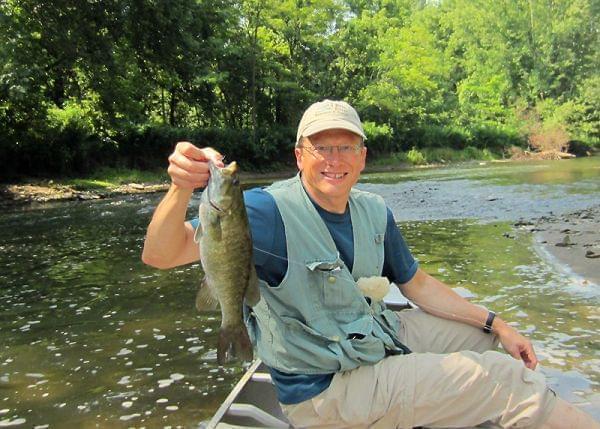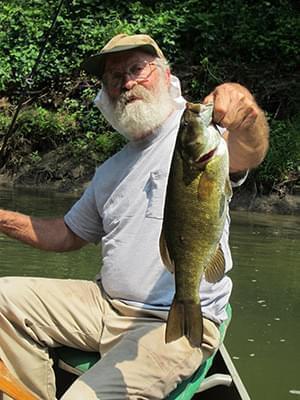Floating, Fishing on the Salt Fork River

Rob Kanter with a smallmouth bass on the Salt Fork River Rick Larimore
On the first Saturday of this month I floated a stretch of Salt Fork River in Vermilion County, something I’ve been meaning to do all summer. I went with my friend Rick Larimore, and our original plan was to float separately, me in my kayak and him in his canoe. I was intent on fishing, though, and Rick said he wasn’t, so he invited me to ride along in his boat and let him do all the paddling. Fortunately, he also grabbed a fishing rod at the last moment, “just in case.”
By August, the Salt Fork typically runs low and clear, which favors anglers looking for smallmouth bass. The bigger fish become concentrated in deep pools, and it’s easy to distinguish those pools from the long, flat stretches, something that’s trickier when the water is murky early in the season.
We came into the first deep pool by way of a narrow, fast riffle only 20 minutes after getting on the water. I was fishing with a weighted fly that I just let drift in front of the canoe. As it hit the end of the riffle my line tightened and I set the hook. The fish I had on, which I landed minutes later, was as big as any bass I’ve ever caught on a fly rod.
If you’re an angler yourself (or you’re familiar with the species) you know my friend needed no further prompting to put down his paddle and pick up his fishing rod. I won’t bore you with the details, but we caught more than a dozen bass between us that day. We fared better in some stretches of river than we did in others, but we caught fish in just about every spot that looked good.

Rick Larimore with a smallmouth
I was especially glad to have a good day fishing the Salt Fork. It has been some time since I did, and I had begun to wonder whether rivers otters, which now thrive both there and in the Middle Fork, hadn’t greatly reduced the bass population.
River otters have done phenomenally well in the state since the Illinois Department of Natural Resources reintroduced them in the mid 1990s and I am glad for every opportunity to see them in the wild. I’ll be even gladder now, knowing any lack of success I experience fishing can’t be pinned on them.
Of course there’s more to paddling on a river than just fishing.
The birding on this trip was remarkable. An osprey cruised over us before we even came to a stop at the bridge where we put in. Kingfishers, spotted sandpipers and great blue herons took off downstream to escape us as we drifted toward them, sometimes seeming annoyed that we kept coming after them. At one point a bald eagle circled overhead, just above the tops of the tallest riverside trees, then landed looking down on us from an ancient cottonwood.
I write about my enjoyment of the natural world to encourage other people to take advantage of the treasures we have access to in central Illinois. In doing so, I think it’s also important to call attention to why we have that access. The Salt Fork River—and rivers like it across the country—were once treated by industry as sewers and rendered unfit for use by wildlife or people. But during the course of my lifetime they’ve come back, thanks in large part to the federal Clean Water Act that forced polluters to take responsibility for their waste.

